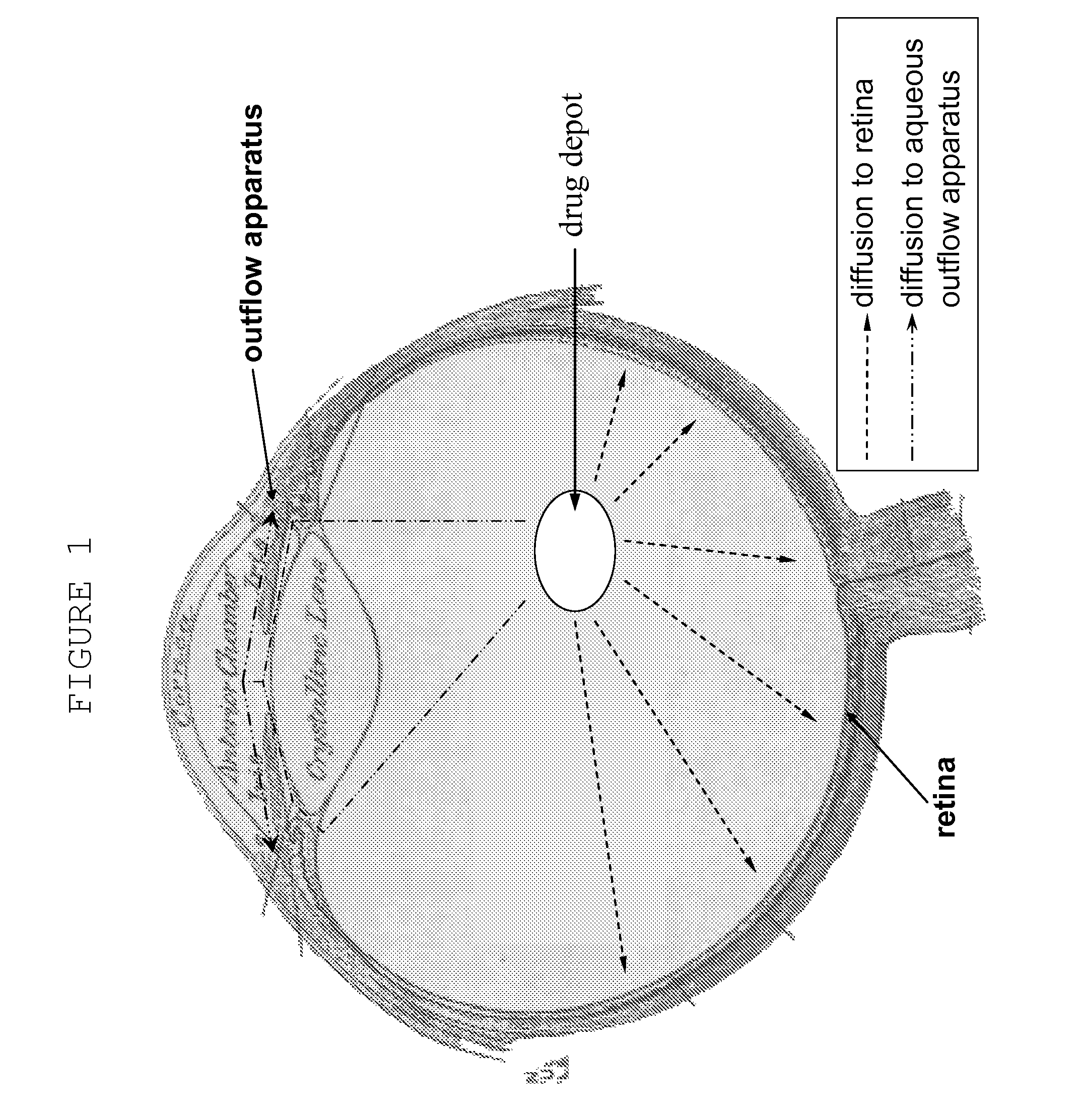Ocular therapy using glucocorticoid derivatives selectively penetrating posterior segment tissues
a technology of glucocorticoid derivatives and posterior segment tissues, which is applied in the direction of prosthesis, drug compositions, extracellular fluid disorders, etc., can solve the problems of limiting the effective use of such agents, serious side effects, and glucose intoleran
- Summary
- Abstract
- Description
- Claims
- Application Information
AI Technical Summary
Benefits of technology
Problems solved by technology
Method used
Image
Examples
example 1
[0144]Recombinant vascular endothelial growth factor (VEGF) was obtained from a supplier (R&D Systems). Female Dutch Belt rabbits were anaesthetized with isoflurane inhalation and topical 0.5% proparacaine hydrochloride, and intravitreal injection of one eye with 500 ng VEGF in sterile phosphate buffered saline (PBS) containing 0.1% bovine serum albumin was performed using a 28 guage ½ inch needle. The other eye is given the same volume of the vehicle, without the VEGF.
[0145]The extent of VEGF-induced BRB and BAB breakdown of the blood retinal barrier and the blood aqueous barrier was measured by scanning ocular fluorophotemetry (Fluorotron Master, Ocumetrics Inc.); at various times following intravitreal injection. In this model a fluorescent label is administered intravenously, following by determination of the amount of fluorescenin in the anterior and posterior segment and an indication of iridial and retinal leakage, respectively.
[0146]Under normal conditions the blood retinal ...
example 2
GD Implant
[0160]Biodegradable drug delivery systems can be made by combining a GD with a biodegradable polymer composition in a stainless steel mortar. The combination is mixed via a Turbula shaker set at 96 RPM for 15 minutes. The powder blend is scraped off the wall of the mortar and then remixed for an additional 15 minutes. The mixed powder blend is heated to a semi-molten state at specified temperature for a total of 30 minutes, forming a polymer / drug melt.
[0161]Rods are manufactured by pelletizing the polymer / drug melt using a 9 gauge polytetrafluoroethylene (PTFE) tubing, loading the pellet into the barrel and extruding the material at the specified core extrusion temperature into filaments. The filaments are then cut into about 1 mg size implants or drug delivery systems. The rods have dimensions of about 2 mm long×0.72 mm diameter. The rod implants weigh between about 900 μg and 1100 μg.
[0162]Wafers are formed by flattening the polymer melt with a Carver press at a specifie...
example 3
Manufacture of Double Extrusion GD Implant
[0166]Double extrusion methods may also be used for the manufacture of GD implants. Such implants can be made as follows, and as set forth in as set forth in U.S. patent application Ser. No. 10 / 918,597, hereby incorporated by reference herein.
[0167]Thirty grams of RG502 were milled using the Jet-Mill (a vibratory feeder) at milling pressures of 60 psi, 80 psi and 80 psi for the pusher nozzle, grinding nozzle, and grinding nozzle, respectively. Next, 60 grams of RG502H were milled using the Jet-Mill at milling pressure of 20 psi, 40 psi and 40 psi for the pusher nozzle, grinding nozzle, and grinding nozzle, respectively. The mean particle size of both RG502 and RG502H is measured using a TSI 3225 Aerosizer DSP Particle Size Analyzer. Both milled polymers have a mean particle size of no greater than 20 um.
[0168](b) Blending of GD and PLGA
[0169]48 grams of beclamethasone diproprionate (“DP”), 24 grams of milled RG502H and 8 grams of milled RG50...
PUM
| Property | Measurement | Unit |
|---|---|---|
| solubility | aaaaa | aaaaa |
| solubility | aaaaa | aaaaa |
| solubility | aaaaa | aaaaa |
Abstract
Description
Claims
Application Information
 Login to View More
Login to View More - R&D
- Intellectual Property
- Life Sciences
- Materials
- Tech Scout
- Unparalleled Data Quality
- Higher Quality Content
- 60% Fewer Hallucinations
Browse by: Latest US Patents, China's latest patents, Technical Efficacy Thesaurus, Application Domain, Technology Topic, Popular Technical Reports.
© 2025 PatSnap. All rights reserved.Legal|Privacy policy|Modern Slavery Act Transparency Statement|Sitemap|About US| Contact US: help@patsnap.com



